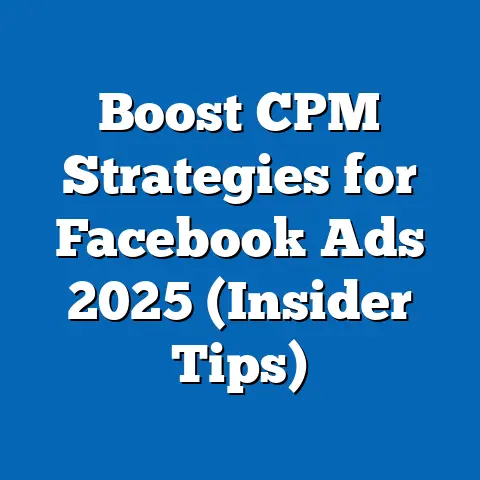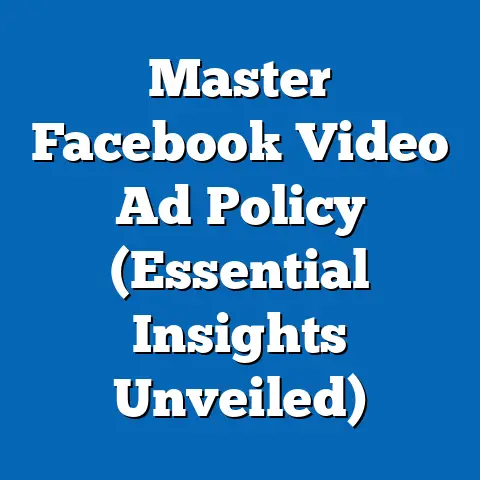Unlocking Facebook Ads Comment Insights (Expert Strategy)
I remember the first time I truly understood the power of Facebook ads comments. I was helping a local bakery run a campaign for their new gluten-free line. We were excited, the visuals were stunning, and the targeting was precise. But what truly surprised us wasn’t the initial surge in likes or shares; it was the comments. People were asking about ingredients, sharing their personal experiences with gluten intolerance, and even suggesting new product ideas. It was a goldmine of information that went far beyond simple engagement. That’s when I realized that comments are more than just noise; they’re a direct line to your audience’s thoughts, feelings, and needs. In this guide, I’ll walk you through how to unlock these insights and transform them into a powerful competitive advantage.
The Importance of Comments in Facebook Ads
Facebook ads are a powerhouse for reaching a broad audience, but their true potential lies in the feedback loop created by comments. While likes and shares give you a general sense of engagement, comments offer something far more valuable: qualitative data that reveals the “why” behind the “what.” They provide a direct line to your audience’s thoughts, feelings, and needs, offering real-time feedback on your products, services, and overall brand perception.
Think of it this way: Likes are like a quick thumbs-up, while comments are like a mini focus group happening right under your ad. They can tell you:
- What people think of your product or service: Are they excited? Skeptical? Confused?
- What their needs and pain points are: What are they hoping to achieve with your product? What problems are they trying to solve?
- What they expect from your brand: Do they value quality, affordability, or customer service?
- What they suggest for improvement: Are there features they’d like to see? Are there ways you can make their experience better?
In today’s competitive landscape, understanding these nuances is crucial. According to recent studies, brands that actively listen to and respond to customer feedback are more likely to build stronger relationships and foster loyalty. Comments provide a direct and unfiltered way to access this feedback, giving you a distinct edge over competitors who only focus on superficial metrics.
Key Takeaway: Don’t just dismiss comments as background noise. They are a valuable source of insights that can help you refine your marketing strategy, improve your products, and build stronger relationships with your audience.
Types of Comments to Look For
Not all comments are created equal. To effectively analyze them, it’s important to categorize them based on their content and sentiment. Here’s a breakdown of the different types of comments you should be looking for:
-
Positive Comments: These express enthusiasm, satisfaction, or appreciation for your product or service. They’re a great way to identify what’s working well and reinforce positive brand associations.
- Example: “Just received my order and I’m absolutely in love! The quality is amazing and the shipping was super fast.”
- Leverage: Share these comments as testimonials, highlight them in your marketing materials, and use them to identify your product’s strengths.
-
Negative Comments: These express dissatisfaction, frustration, or criticism. While they can be uncomfortable to read, they offer invaluable insights into areas where you need to improve.
-
Example: “I ordered this product last week and it still hasn’t arrived. Customer service hasn’t been helpful either.”
- Leverage: Address these comments promptly and professionally. Offer solutions, apologize for any inconvenience, and use the feedback to identify and fix underlying issues.
-
Questions: These seek clarification about your product, service, or brand. They can indicate areas where your messaging is unclear or where you need to provide more information.
-
Example: “Does this product come in other colors?”
- Leverage: Answer these questions promptly and thoroughly. Use them to identify gaps in your product information and improve your FAQs.
-
Suggestions: These offer ideas for new features, improvements, or products. They can be a goldmine of innovation and help you stay ahead of the curve.
-
Example: “It would be great if this product had a built-in timer.”
- Leverage: Take these suggestions seriously. Consider implementing them in future product updates or using them as inspiration for new product development.
-
Neutral Comments: These are generally informational or factual and don’t express strong positive or negative sentiment.
-
Example: “Thanks for sharing.”
- Leverage: While these may not offer immediate insights, they can still contribute to overall engagement and brand visibility.
Positive Comments: These express enthusiasm, satisfaction, or appreciation for your product or service. They’re a great way to identify what’s working well and reinforce positive brand associations.
- Example: “Just received my order and I’m absolutely in love! The quality is amazing and the shipping was super fast.”
- Leverage: Share these comments as testimonials, highlight them in your marketing materials, and use them to identify your product’s strengths.
-
Negative Comments: These express dissatisfaction, frustration, or criticism. While they can be uncomfortable to read, they offer invaluable insights into areas where you need to improve.
-
Example: “I ordered this product last week and it still hasn’t arrived. Customer service hasn’t been helpful either.”
- Leverage: Address these comments promptly and professionally. Offer solutions, apologize for any inconvenience, and use the feedback to identify and fix underlying issues.
-
Questions: These seek clarification about your product, service, or brand. They can indicate areas where your messaging is unclear or where you need to provide more information.
-
Example: “Does this product come in other colors?”
- Leverage: Answer these questions promptly and thoroughly. Use them to identify gaps in your product information and improve your FAQs.
-
Suggestions: These offer ideas for new features, improvements, or products. They can be a goldmine of innovation and help you stay ahead of the curve.
-
Example: “It would be great if this product had a built-in timer.”
- Leverage: Take these suggestions seriously. Consider implementing them in future product updates or using them as inspiration for new product development.
-
Neutral Comments: These are generally informational or factual and don’t express strong positive or negative sentiment.
-
Example: “Thanks for sharing.”
- Leverage: While these may not offer immediate insights, they can still contribute to overall engagement and brand visibility.
Negative Comments: These express dissatisfaction, frustration, or criticism. While they can be uncomfortable to read, they offer invaluable insights into areas where you need to improve.
Example: “I ordered this product last week and it still hasn’t arrived. Customer service hasn’t been helpful either.”
Questions: These seek clarification about your product, service, or brand. They can indicate areas where your messaging is unclear or where you need to provide more information.
Example: “Does this product come in other colors?”
Suggestions: These offer ideas for new features, improvements, or products. They can be a goldmine of innovation and help you stay ahead of the curve.
Example: “It would be great if this product had a built-in timer.”
Neutral Comments: These are generally informational or factual and don’t express strong positive or negative sentiment.
Example: “Thanks for sharing.”
Understanding the sentiment behind each comment is crucial. Sentiment analysis tools can help you automate this process, identifying the emotional tone of each comment and categorizing them accordingly. These tools use natural language processing (NLP) to analyze text and determine whether it expresses positive, negative, or neutral sentiment.
Key Takeaway: By categorizing and analyzing comments based on their content and sentiment, you can gain a deeper understanding of your audience’s perceptions and identify areas where you can improve your marketing strategy and product offerings.
Tools and Techniques for Analyzing Comments
Analyzing Facebook ads comments can seem daunting, especially if you’re running large-scale campaigns. Thankfully, there are a variety of tools and techniques available to help you streamline the process and extract valuable insights.
1. Manual Analysis:
Don’t underestimate the power of simply reading through your comments! While it’s time-consuming, manual analysis allows you to develop a deep understanding of the nuances and context behind each comment. Here’s a step-by-step guide:
- Set aside dedicated time: Carve out specific blocks of time each week to review your comments.
- Categorize comments: Use a spreadsheet or notepad to categorize comments based on the types outlined in the previous section (positive, negative, questions, suggestions, neutral).
- Identify recurring themes: Look for patterns and trends in the comments. Are there specific issues that keep coming up? Are there certain features that people are consistently praising?
- Prioritize actionable insights: Focus on the comments that offer the most valuable insights and can be translated into actionable strategies.
- Document your findings: Keep a record of your analysis, including key takeaways and recommendations.
2. Facebook’s Built-in Tools:
Facebook offers several built-in tools that can help you analyze your ads comments:
- Ads Manager: The Ads Manager provides basic metrics on comment engagement, such as the number of comments and the average sentiment.
- Facebook Business Suite: This platform allows you to manage all your Facebook and Instagram activities in one place, including monitoring and responding to comments.
- Comment Moderation Tools: Facebook’s comment moderation tools allow you to hide or delete inappropriate comments, block users, and set up keyword filters to automatically hide comments containing certain words or phrases.
3. Third-Party Sentiment Analysis Tools:
These tools use NLP to automatically analyze the sentiment behind each comment, saving you time and effort. Some popular options include:
- Brand24: This tool tracks mentions of your brand across the web, including Facebook, and provides sentiment analysis, keyword tracking, and social listening features.
- Mention: Similar to Brand24, Mention tracks brand mentions across various platforms and offers sentiment analysis, influencer identification, and competitive analysis features.
- Hootsuite Insights: This social media management platform includes sentiment analysis capabilities, allowing you to track the overall sentiment towards your brand on Facebook and other social networks.
4. Social Listening Platforms:
These platforms go beyond just analyzing comments on your ads and track conversations about your brand across the entire social web. They can provide valuable insights into broader trends and sentiment. Some popular options include:
- Sprout Social: This platform offers social listening, publishing, and analytics features, allowing you to track brand mentions, monitor sentiment, and engage with your audience.
- Talkwalker: This platform provides advanced social listening capabilities, including sentiment analysis, trend identification, and competitive analysis.
Key Takeaway: Choose the tools and techniques that best fit your needs and budget. Whether you opt for manual analysis, Facebook’s built-in tools, or third-party solutions, the key is to be proactive in monitoring and analyzing your comments.
Turning Insights into Action
Analyzing comments is only half the battle. The real magic happens when you translate those insights into actionable marketing strategies. Here’s how to turn comment feedback into tangible results:
-
Improve Your Product or Service: Negative comments and suggestions can highlight areas where your product or service is falling short. Use this feedback to make improvements and address customer pain points.
- Example: If customers are complaining about a specific feature being difficult to use, consider redesigning it or providing more detailed instructions.
-
Refine Your Messaging: Questions and concerns can indicate that your messaging is unclear or confusing. Use this feedback to refine your ad copy, landing pages, and other marketing materials.
-
Example: If customers are constantly asking about pricing, make sure your pricing information is clearly displayed in your ads and on your website.
-
Adjust Your Targeting: Comments can reveal insights into your target audience’s demographics, interests, and needs. Use this information to refine your targeting parameters and reach a more relevant audience.
-
Example: If you’re seeing a lot of comments from customers in a specific age group or location, consider targeting your ads more specifically to that demographic.
-
Respond to Comments and Engage with Your Audience: Responding to comments shows that you’re listening and that you care about your customers’ feedback. This can help build trust and loyalty, and even turn negative comments into positive brand experiences.
-
Example: If a customer is complaining about a delayed shipment, apologize for the inconvenience and offer a solution, such as a discount on their next order.
-
Create New Content: Questions and suggestions can inspire new content ideas that resonate with your audience.
-
Example: If customers are asking for tips on how to use your product, create a blog post or video tutorial that addresses their questions.
Improve Your Product or Service: Negative comments and suggestions can highlight areas where your product or service is falling short. Use this feedback to make improvements and address customer pain points.
- Example: If customers are complaining about a specific feature being difficult to use, consider redesigning it or providing more detailed instructions.
-
Refine Your Messaging: Questions and concerns can indicate that your messaging is unclear or confusing. Use this feedback to refine your ad copy, landing pages, and other marketing materials.
-
Example: If customers are constantly asking about pricing, make sure your pricing information is clearly displayed in your ads and on your website.
-
Adjust Your Targeting: Comments can reveal insights into your target audience’s demographics, interests, and needs. Use this information to refine your targeting parameters and reach a more relevant audience.
-
Example: If you’re seeing a lot of comments from customers in a specific age group or location, consider targeting your ads more specifically to that demographic.
-
Respond to Comments and Engage with Your Audience: Responding to comments shows that you’re listening and that you care about your customers’ feedback. This can help build trust and loyalty, and even turn negative comments into positive brand experiences.
-
Example: If a customer is complaining about a delayed shipment, apologize for the inconvenience and offer a solution, such as a discount on their next order.
-
Create New Content: Questions and suggestions can inspire new content ideas that resonate with your audience.
-
Example: If customers are asking for tips on how to use your product, create a blog post or video tutorial that addresses their questions.
Refine Your Messaging: Questions and concerns can indicate that your messaging is unclear or confusing. Use this feedback to refine your ad copy, landing pages, and other marketing materials.
Example: If customers are constantly asking about pricing, make sure your pricing information is clearly displayed in your ads and on your website.
Adjust Your Targeting: Comments can reveal insights into your target audience’s demographics, interests, and needs. Use this information to refine your targeting parameters and reach a more relevant audience.
Example: If you’re seeing a lot of comments from customers in a specific age group or location, consider targeting your ads more specifically to that demographic.
Respond to Comments and Engage with Your Audience: Responding to comments shows that you’re listening and that you care about your customers’ feedback. This can help build trust and loyalty, and even turn negative comments into positive brand experiences.
Example: If a customer is complaining about a delayed shipment, apologize for the inconvenience and offer a solution, such as a discount on their next order.
Create New Content: Questions and suggestions can inspire new content ideas that resonate with your audience.
Example: If customers are asking for tips on how to use your product, create a blog post or video tutorial that addresses their questions.
I once worked with a clothing retailer that received numerous comments on their Facebook ads complaining about limited sizing options. Initially, they were hesitant to expand their size range, fearing it would be too costly. However, after analyzing the comments and realizing the significant demand for larger sizes, they decided to take the plunge. The result? A massive increase in sales and a surge in positive brand sentiment.
Key Takeaway: Don’t just passively collect comments. Actively use them to improve your product, refine your messaging, adjust your targeting, engage with your audience, and create new content.
Measuring the Impact of Comment Insights
Implementing changes based on comment insights is a great start, but it’s crucial to measure the effectiveness of those changes to ensure you’re on the right track. Here are some key performance indicators (KPIs) to track:
- Engagement Rate: Monitor the engagement rate of your ads (likes, shares, comments) after implementing changes based on comment feedback. An increase in engagement rate indicates that your changes are resonating with your audience.
- Conversion Rate: Track the conversion rate of your ads (e.g., purchases, leads) after implementing changes. An increase in conversion rate indicates that your changes are driving more sales or leads.
- Customer Satisfaction: Measure customer satisfaction through surveys, reviews, and social media monitoring. An increase in customer satisfaction indicates that your changes are improving the overall customer experience.
- Brand Sentiment: Track the overall sentiment towards your brand on social media. An improvement in brand sentiment indicates that your changes are positively impacting your brand perception.
- Cost Per Acquisition (CPA): Monitor your CPA after implementing changes. A decrease in CPA indicates that you’re acquiring customers more efficiently.
Here’s a hypothetical scenario to illustrate the potential ROI of utilizing comment insights:
- Scenario: You’re running a Facebook ad campaign for a new fitness app. You notice that many users are commenting that they’re confused about how to use a particular feature.
- Action: You create a short video tutorial explaining how to use the feature and add it to your landing page.
- Results:
- Engagement rate increases by 20%.
- Conversion rate increases by 10%.
- Customer satisfaction scores increase by 15%.
- CPA decreases by 5%.
- Engagement rate increases by 20%.
- Conversion rate increases by 10%.
- Customer satisfaction scores increase by 15%.
- CPA decreases by 5%.
In this scenario, by simply addressing a common concern raised in the comments, you were able to significantly improve the performance of your ad campaign and drive tangible business results.
Key Takeaway: Continuously monitor your KPIs to measure the effectiveness of changes made based on comment insights. This will help you optimize your Facebook ad strategy and maximize your ROI.
Conclusion
Facebook ads comments are a treasure trove of insights waiting to be unlocked. By actively monitoring, analyzing, and acting on this feedback, you can gain a deeper understanding of your audience, improve your product or service, refine your messaging, and drive tangible business results.
Don’t let these valuable insights go to waste. Start integrating comment analysis into your Facebook ad strategy today and unlock new opportunities for growth and engagement. Respond to your audience, learn from their feedback, and watch your campaigns transform. The power is in your hands (and in their comments)!






